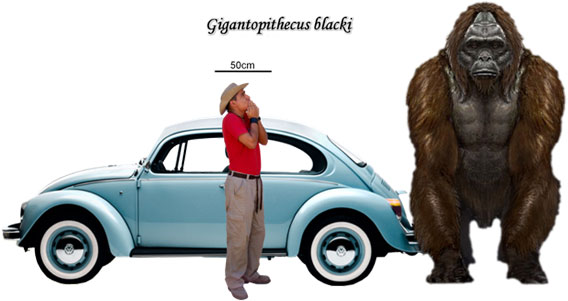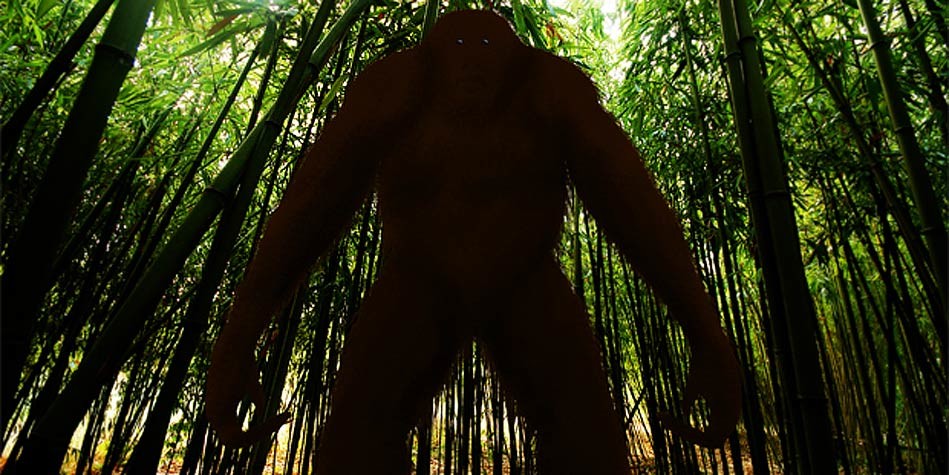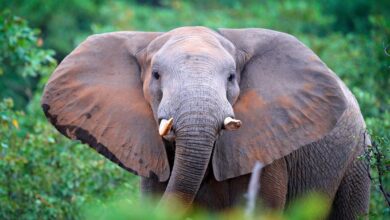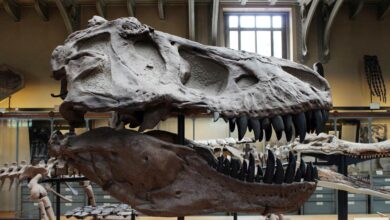Gigantopithecus – the largest ape that ever lived
Almost King Kong
In many regions of the world, there are stories of tall, humanoid creatures covered with hair and running away from the sight of people. Are Yeti or Bigfoot a surviving form of Gigantopithecus – the largest hominid ever discovered?
Classification
- Class: Mammalia
- Order: Primates
- Parvorder: Apes
- Family: Hominidae
- Subfamily: Ponginae
- Genus: Gigantopithecus
- Species:
- Gigantopithecus blacki
- Gigantopithecus bilaspurensis
- Gigantopithecus giganteus
Occurrence
This enormous ape lived in the regions of modern-day China, India, and Vietnam, probably between 9 million and 100 thousand years ago. Gigantopithecus coexisted with other hominids, but what distinguished it from them was its gigantic size.
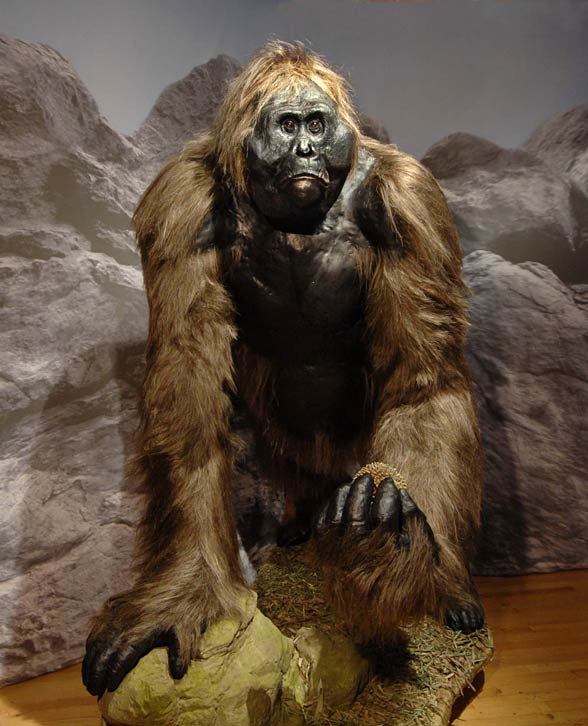
Characteristic
Most experts believe that Gigantopithecus walked on 4 legs, similarly to modern-day chimpanzees or gorillas. There are also assumptions that it was bipedal. The assumption about bipedalism is based only on the jaw bones whose shape resembles the letter U, widening towards the rear. This feature allowed room for the windpipe, and the jaw was attached perpendicularly to the spine, which may suggest an erect posture.
It is difficult to determine the validity of both beliefs, because the pelvic and leg bones have never been found. But having in mind that Gigantopithecus was a very massive creature (a male could have weighed even 540 kg (1,190 lb)), the legs wouldn’t be able to support such weight. If Gigantopithecus moved as the gorilla, its weight would be distributed proportionally on all limbs, which would enable it to move ably.
Gigantopithecus lived in bamboo forests with the extinct genus of the panda, which has been proved by found fossils. Therefore, it is considered to have been herbivorous.
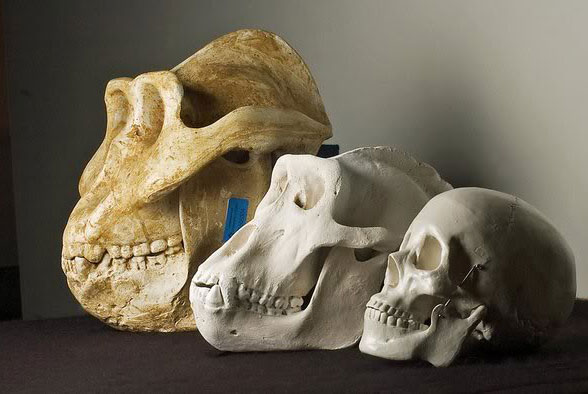
The jaw was massive and deep. The teeth were big, intended for chewing, crunching, and pounding food. Gigantopithecus could have dealt easily with fiber crops, similar to bamboo. Apart from bamboo, Gigantopithecus likely fed on seeds and fruit, which has been indicated by phytoliths found on its teeth. The molars were short and flat, but covered with extremely strong tooth enamel – it’s a pity that we don’t have it, we wouldn’t have to visit a dentist 🙂
The premolars looked similar, and the canines were neither too sharp, nor peaked. The incisors didn’t amaze with their size and they resembled a chisel. All teeth had many hollow areas, and the analogical teeth structure can be nowadays observed in giant pandas, whose diet consists mostly of bamboo.
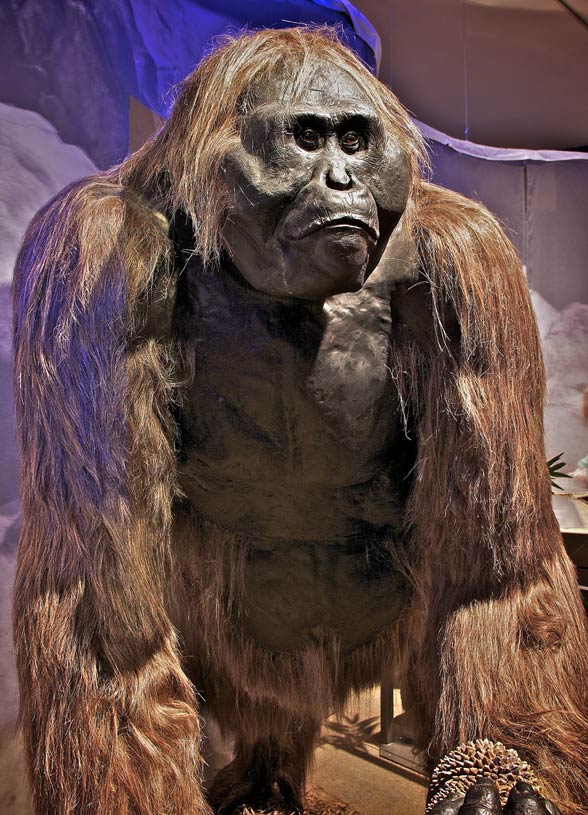
Because the skeleton of Gigantopithecus is incomplete, the reconstruction of this creature is mostly speculation, but the parts that have been found reveal quite interesting information. Because of the size of Gigantopithecus, it could be stated that the gorilla is its closest modern-day relative. However, the jaw which was smaller than the gorilla’s suggests that Gigantopithecus is more closely related to the orangutan (Pongo). Created models of Gigantopithecus clearly show the resemblance to the ape of the Pongo genus. The reconstructed giant usually stands on two legs, but it is to show its impressive size.
The theory about bipedalism is highly doubtful, but it is possible, that from time to time Gigantopithecus stood in an upright position (e.g. while competing with other males or travelling).
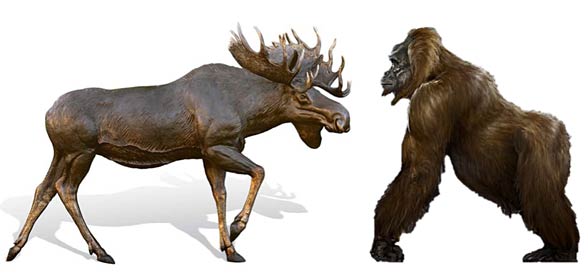
Discovery
The first description was made by an anthropologist – Ralph von Koenigswald – in 1935. The story is incredible inasmuch as the researcher made his discovery in… a Chinese drugstore. The fossilized teeth and bones were powdered and used as a medication in traditional Chinese medicine. Molars and some jaws have been retrieved from the store with traditional medications. Other remains of Gigantopithecus have been found in India and Vietnam.
In 1955, 47 teeth of Gigantopithecus blacki were found among transported “dragon bones” (pieces of bones or shells intended for divination, e.g. scapulimancy). By the analysis of the provenance of the teeth, larger finds have been discovered, including an almost complete jaw. Until 1958 3 jaws and over 1300 teeth were found, mostly in stockrooms for Chinese medications, and in caves.
Not all remains are dated the same period – the fossils from Hubei Province seem to be the oldest among all Chinese finds (other remains come from Guangxi and Sichuan). The teeth from Hubei are also bigger.
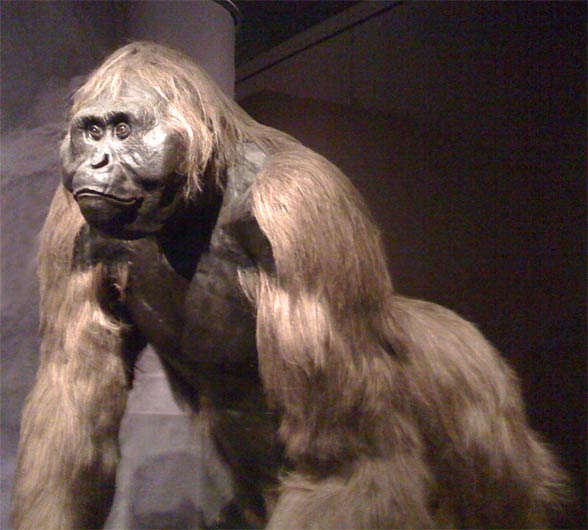
Species
Nowadays 3 species of Gigantopithecus have been classified:
Gigantopithecus blacki
Known only from its jaw bones and teeth found in caves in south-eastern Asia. The species name suggests that this creature was much larger than the modern-day gorilla, but the exact size and stature remain unknown. Thanks to various methods of dating, it was shown that this creature lived about 1 million years ago, and went extinct about 100,000 years ago. Thus, at the final stage, Gigantopithecus coexisted with humans (Homo sapiens – appeared about 190 thousand years ago) and the preceding “upright man” (Homo erectus: 1.9 million – 143 thousand years ago).
On the basis of found fossils it was calculated that an adult male had measured about 3 meters (9ft 10in) of height and weighed 540 kg (1190 lb). The largest male representatives of the species could have reached over 3 meters of height.
This creature fed on plants, similar to those eaten by the giant panda. The appearance of Gigantopithecus hasn’t been known well because of partial finds. It could have resembled the modern-day gorilla, but researchers prefer the theory saying that it resembled its closest relative – the orangutan.
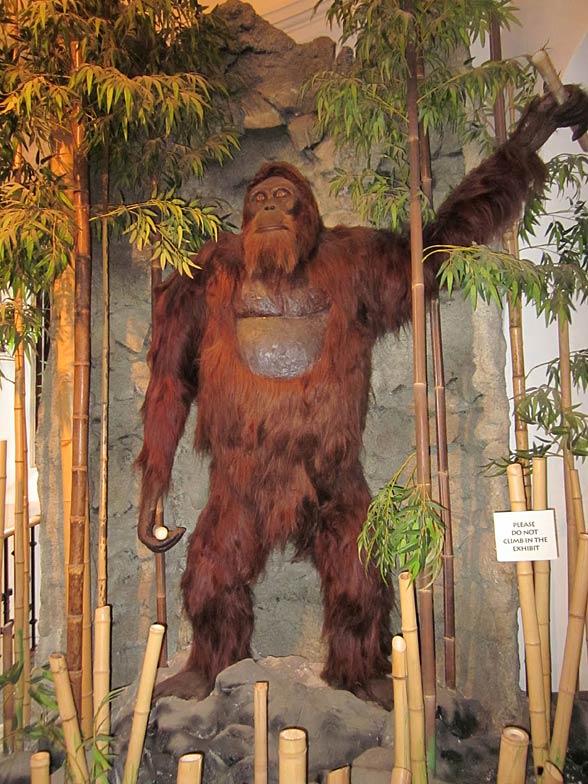
Gigantopithecus bilaspurensis
A very large species of apes, whose history has been known from a few bones and teeth found in India. The species lived 6-9 million years ago, in the Miocene. It is related to Gigantopithecus blacki.
Gigantopithecus giganteus
Teeth have been found in limestone formations in Daxin and Wuming, north of Nanning (Chinese province Guangxi) and in northern India. Despite its name, it is believed that the species was half the size of Gigantopithecus blacki. Probably it was terrestrial and herbivorous (fed mostly on bamboo and leaves).
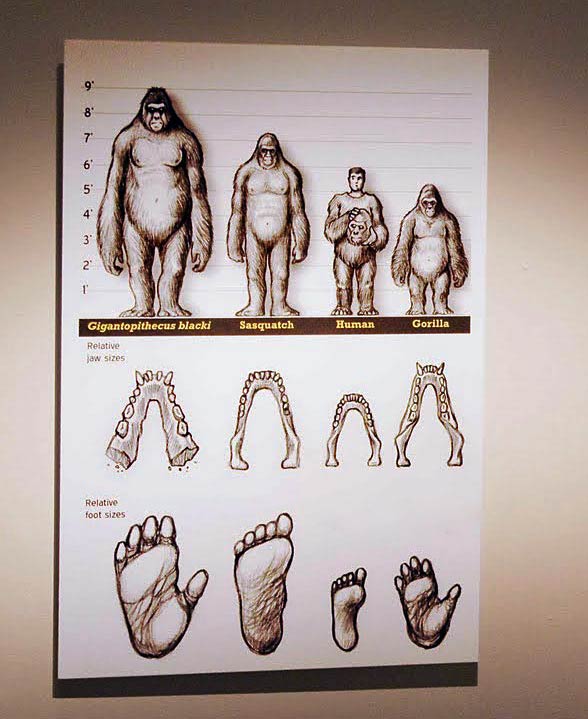
Yeti, Yowie, Alma, Orang Pendek, Sasquatch – are they all Gigantopithecus?
Not only Sherpa people talk about the Yeti – a large animal resembling a cross-bred between an ape and human, living in the Himalayas.
- Yowie can be characterized in a similar way – a wild man who has been seen by the Aborigines – the indigenous peoples of Australia.
- Peoples of Mongolia and Siberia, in turn, have met Alma.
- American Indians, before the arrival of white settlers, used to tell stories about Sasquatch, namely, Big Foot.
- Orang Pendek (short person), in turn, is found in Sumatran forests.
Officially it is recognized that these creatures are only the creations of fanatics and adherents of conspiracy theories.
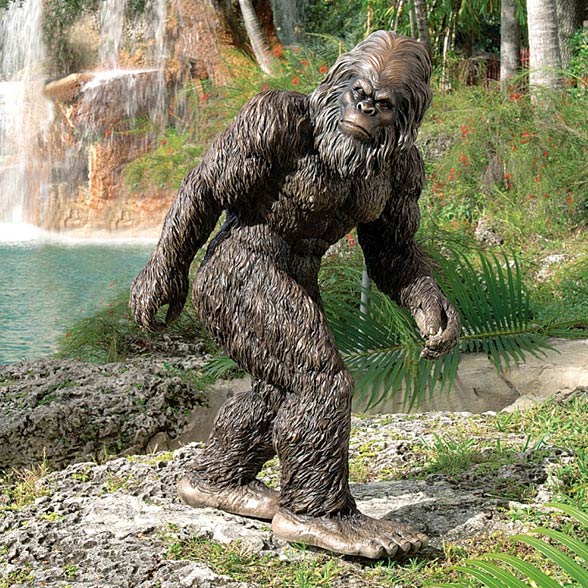
Trails?
However, there are trails that may wipe the smiles off skeptics’ faces. In 2008, members of a Japanese expedition noticed a footprint in the snow, which was 50 cm long. One of the theories says that the “author” of that footprint was a living Gigantopithecus.
The first mentions of creatures inhabiting remote locations and resembling an ape-man are dated the 15th century. In Europe, people heard about mythical creature only at the end of 20th century, when an English colonel Wandell confessed that he had seen several strange creatures with bare feet in northern India. Sherpa – Tibetan people – have been seeing such an animal for a long time and named it Yeti.
One of the hypotheses associated with the Yeti explains that it is, in fact, not an ape-man, but…. a bear. You can find out more about it in the article: the Tibetan blue bear.
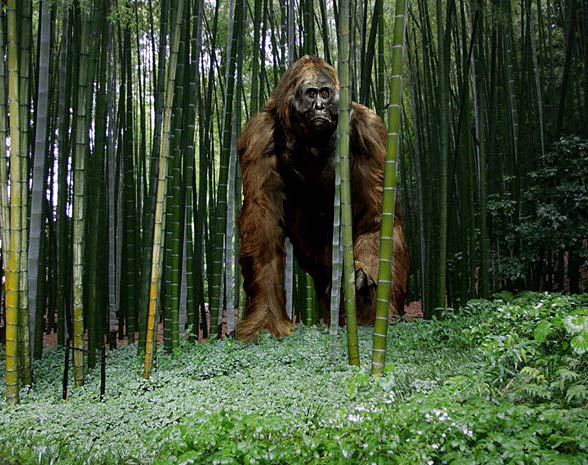
Detailed information / size
Gigantopithecus
- Height: to 3 meters (9ft 10in), females were lower by half
- Armspan: over 3.6 m (12 ft)
- Weight: to 540 kg (1,190 lb)
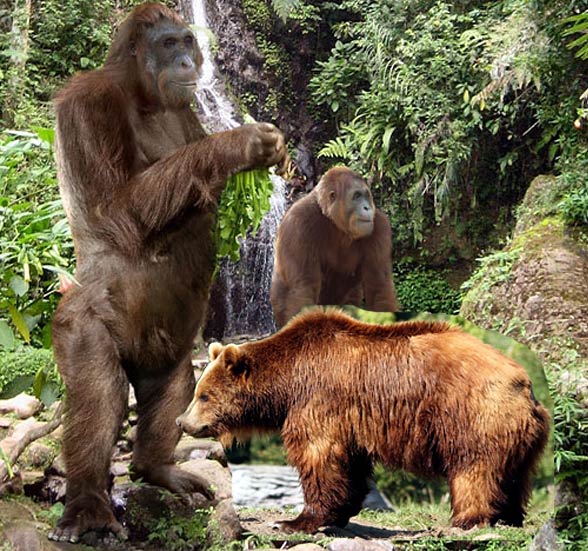
Gigantopithecus – interesting facts
- Researchers have calculated that Gigantopithecus was 2-3 times heavier than the modern-day gorilla, and almost 5 times heavier than the modern-day orangutan.
- Because of significant interspecific diversities in teeth and body size, some researchers believe that Gigantopithecus was much smaller (about 1.8 m (5ft 11in) of height) than it is officially claimed.
- Thanks to its large size, an adult individual had very few natural enemies, however, younger, weaker, or sick creatures used to become the prey of tigers, crocodiles, hyenas, pythons, bears, saber-toothed tigers and Homo erectus.
- In the past, it was believed that Gigantopithecus had been related to humans, but nowadays it is believed that the resemblance to humans is the result of convergent evolution.
- In 2012, in Dallas, the DNA of an unknown hominid was tested. The DNA sequence suggests that the legendary Sasquatch (Bigfoot) is a hybrid between Homo sapiens and an unknown primate. A “human-animal hybrid” is the term used in relation to this find.
